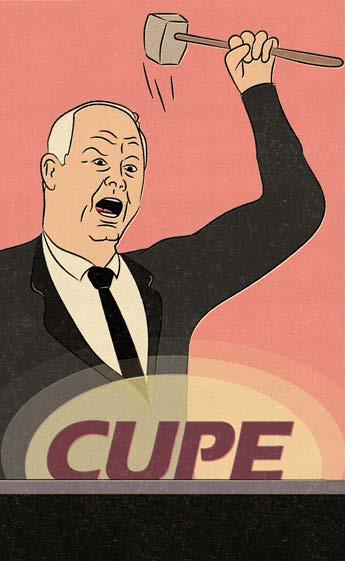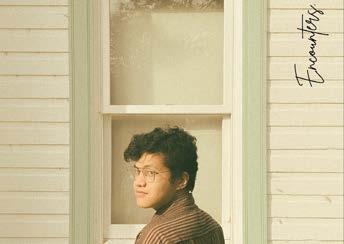
15 minute read
Comment pages 8 and
O’Toole the same old union buster Canadians are used to
Conservative leadership will set labour on a damaging trajectory
COMMENT
Lucas Edmond, staff Canadian labour is entering the 2021 election in dire straits. Union density has been steadily declining since the 1980s. Although the Liberal party victory in 2015 gave hesitant hope for improved union membership, the results have been underwhelmingly stagnant. From 1981 to 2014, unionization rates plummeted from 37.6 per cent to 28.8 per cent and improved roughly two per cent by 2020. Little about this is surprising to labour leaders. However, with the Conservative party vying for leadership, labour may be faced with a new challenge.
Conservative leader Erin O’Toole has championed labour policies pundits are calling union-friendly. However, many of the policies he has addressed publicly are little more than embellishments for far more sinister reform.
In August, O’Toole announced he would purportedly “ensure” workers are represented on the boards of large federally regulated private corporations that employ over 1,000 workers or have annual revenues over $100 million. This includes sectors such as oil and gas, trucking, ports, railways, banking, uranium mining, telecommunications, air transportation, crown corporations and more.
O’Toole offered the policy to Canadians with little detail and a lot of political posturing. In the news release outlining his new policy proposal, O’Toole discussed getting workers a seat at the table, taking advantage of a popular rhetorical phrase used by unionists occupying the left side of the political spectrum.
“Too many decisions at major corporations are being made without the people who helped build the company — the workers — at the table,” the news release read.
Instead of using this allegory while simultaneously empowering working-class agency, O’Toole has offered labourers a physical seat at various corporations’ boards. While the idea of O’Toole offering workers an actual seat to keep them docile is humorous, the policy is tokenistic at best. By exploiting union discourse, he may think he can appeal to a new voting base without committing to the cause wholeheartedly.
“Conservatives have essentially run the same campaign over and over again since 2006,” an advisor for O’Toole said in an interview with the conservative-leaning National Post. “If we want to win, we have to do something different.”
O’Toole is likely using this allegedly labour-friendly policy to attract voters. Whether the policy will be implemented to advance tangible material benefits for workers is unlikely. The Conservative party has not indicated the degree of power these representatives will have, how many seats workers will obtain or if the representatives will be glorified advisors that can be pushed aside and ignored by corporate board members.
Fundamentally, this policy won’t change any of the systemic competitive pressures that motivate the exploitation of workers. O’Toole knows this, and it shows considering many of his other labour policies are radically anti-labour.
Take a longer look through O’Toole’s policy declarations, and detailed COVID-19 recovery plan and readers will find the Conservative party is still sternly corporate at heart. Much of this policy is mentioned in brief and seemingly unassuming statements to hide its conservative nature.
For example, in section 14 of the Conservative’s policy declarations, it notes the party “supports right to work legislation to allow optional union membership including student unions.” While this may seem like a moderate commitment, mandatory union dues were a historic victory for labourers when it was first introduced.
Mandatory union dues, part of the Rand formula, were introduced after militant unionists nearly brought the Ford Motor Company in Windsor, Ont. to its knees.
Justice Ivan Rand was responsible for arbitrating the dispute. Workers wanted the manufacturing plant to become a closed shop for union members only so they could negotiate fairly with employers without the threat of workplace lockouts or scab labour — a person who continues to work despite striking co-workers. On the other hand, employers wanted workers to return to the plant without any changes in employment structures.
Rand concluded that while workers should not be forced into association with unions, they should still have to contribute to the costs of collective bargaining. As a result, mandatory union fees became the baseline model for modern labour politics.
The formula ensured the function of unions and a steady progression of worker rights through collective bargaining processes. Should the formula be abandoned, labourers could be helplessly exposed to employers’ economic agendas. This includes the exploitation of more scab labour, which would play a significant role in reducing union influence. Without the Rand formula — or a union with considerable resources to challenge corporate giants — a single seat at a board of directors’ table would be meaningless. party remains committed to setting unionized workers against migrants. Approximately 1.6 million migrant workers don’t have permanent status, making them extremely vulnerable to exploitation.
Migrant labourers lacking permanent status also lack the right to form unions, vote, access universal health care and employment standards that Canadians are accustomed to. As a result, migrant work is often used as a cheaper and more exploitative form of labour to maintain higher rates of corporate surplus. In turn, employers blame migrants for driving down wages and access to employment while they actively partake in repressing their access to basic rights.
With complete citizenship, migrant workers would have access to resources to fight employment abuse, not fear reprisal and contribute to union dues where it applies. Migrant workers have historically been treated poorly by the working class partially due to their informal status.
staff Dallin Chicoine / graphic /
Temporary Foreign Worker Program to provide more power to corporations. The adjusted program would make migrants’ so-called “path to permanence” dependent on employer sponsorship programs. This policy could escalate workplace exploitation by placing unreasonable power in the hands of corporate management.
The path to improved work standards, pay and benefits for all Canadian workers starts with making migrant workers permanent residents.
Although O’Toole has propagated a pro-labour stance publicly, his platform says otherwise. Providing a seat at the board of directors of a large corporation is a manipulative promise that conceals O’Toole’s more controversial labour policy. Pundits can continue to call O’Toole a friend of the labour movement all they want, but post-election he will expose his true form: a conservative politician in a unionist’s clothing.
The 2021 event casts large net from diverse events to locations
ARTS
Grace Paizen, staff Arts enthusiasts can rejoice as Nuit Blanche returns in 2021 for an extended month-long run. Hosted by Culture Days Manitoba, Nuit Blanche will have everything from exhibitions to concerts to culture events spread out over 31 days.
Extending throughout the downtown area and reaching across the city, Nuit Blanche boasts something for everyone, especially for those who may already have become stir-crazy with another online-dominant semester having kicked off.
U of M fine arts students’ artwork will be featured at athletic apparel brand Zueike’s storefront. Like a Manitoban version of a Making the Cut competition, the event culminates with a fine arts student design contest, the winner earning a collaboration with the brand. Zueike is also hosting a contest for students of all ages to create a design for a shirt.
Downtown, Nuit Blanche @ WAGQaumajuq is a one-night only, timed-ticket event, emulating Nuit Blanche’s past. Advance registration to the outing guarantees safe distancing during the event while visitors admire the inaugural Inuit art exhibition at the Qaumajuq Inuit art centre before bopping to some DJ beats on the rooftop patio, complete with the usual rooftop cash bar.
If strolling through the streets is preferable, “Light in the Shadows” is a project by independent artist Penny Kovacs. Her large paintings and mixed media drawings will be displayed along the windows of Freshcut Downtown florist in an art-meetscityscape reverie.
For the folks into music, Project Jazz is a two-night immersive multimedia experience. With visuals from local filmmakers and multimedia artists Mike Maryniuk, Leslie Supnet and Hugh Conacher, the installation takes place in four locations — on the Red River College campus, the Cube at Old Market Square, on the exterior of the Rachel Browne Theatre and the exterior of the King and Bannatyne junction — with projections of jazz music livening up the ever-crisper Winnipeg nights.
Across Main Street, the Native Prairie Mural will spring to life on Amy Street from Sept. 24 to 26. The collaborative and interactive art mural uses wildflowers and grasses to create a prairie landscape over the event’s three nights and offers attendees a chance to add their own flower or poem to the mural.
Over the Esplanade Riel to St. Boniface, Beading on the Land takes place at Théâtre Cercle Molière for the duration of Nuit Blanche. Métis beadworker Charlene Van Buekenhout will go largescale by beading lanterns, instead of beads, into a large flower.
In a comedic twist of timing, the Secret Standup Shows will be featured throughout Nuit Blanche sporadically around the Exchange District and the Forks. The spontaneous pop-up shows will feature Canadian comedians from around the great white north.
The celebration of LGBTTQ* artists will be highlighted in the Reel Pride Art Show and 36th annual Reel Pride Film Festival, held at the same time during Nuit Blanche though dates are not yet finalized. Artwork can be purchased during the Reel Pride Art Show, and the event is free to attend.
In more LGBTTQ* pride, Bannock Babes x ArtsJunktion is a one-nightonly “indigidrag” show featuring drag performances from the Bannock Babes with the stage adorned by Moneca Sinclaire and other Treaty 1 community members’ dreamcatcher works.
For students wishing for some beauty treatments, but who are forced to be frugal with their tight budgets, the Aveda Institute is hosting a complimentary Braid and Brow Bar every Thursday and Friday through the
provided Penny Kovacs / image /

entire run of Nuit Blanche. Get there early to guarantee some much-deserved salon time.
With many more events listed on the Nuit Blanche website, including virtual events, there is something for everyone. Most importantly, this year’s Nuit Blanche allows a great opportunity for a free, fun night out of the dorm, apartment or house and offers more time to spend with exhibits that may have been missed in the time crunch of years past.
Nuit Blanche runs from Sept. 24 to Oct. 24. Event information can be found at nuitblanchewinnipeg.ca.
arts@themanitoban.com
’Toban turntable
SUUNS — ‘The Witness’
ARTS
Kitty Kerr, volunteer
4/5 stars
The release of SUUNS’ fifth full-length album, The Witness, is uncanny in its timing.
The Montreal-based rock band self-recorded and self-produced the album over 2020, one of the strangest, most isolating and revelatory years globally.
The COVID-19 pandemic is not over. The resulting anxiety, solitude and fear are still in process. Some spaces feel safer than they did but it remains difficult to return to ways of being pre- March 2020. And perhaps there will never be a return to the way things once were. Enter the strangely appropriate album The Witness, with a sound so specific it feels like listening to a genre from another planet.
The sound palette is composed of the familiar and the strange. The album opens — and closes — with the sound of cicadas followed by a resonant eerie bass drone and then, finally, the listener is met with something familiar, guitar and percussion. The vocals both soothe and disturb, with singer Ben Shemie’s voice distorted yet sweet.
Shemie himself admits the band’s intention to never “commit to a certain kind of tonality.” “Whether it’d be major or minor, there’s always a certain kind of evading of what your expectation is,” he said in a statement.
He also made explicit the corresponding significance of the album’s title and lyrics.
“There’s something interesting about the idea a collective witness, being a witness to the time we’re living in now, and the connectedness of what we all have in common.”
Expectations are inherent in the reintegration of socializing after a year of lockdowns and isolation. Social expectations in normal circumstances are seldom met. The heightened expectations of social situations presently are consistent and profound disappointments. This sonar evasion from SUUNS feels
provided / Aim Media image /
appropriate and somehow comforting in the strangeness of reality.
Want us to review your band? Email arts@themanitoban.com!
Shining a light on the surveillance state
‘All Light, Everywhere’ focuses its lens on the history of policing
ARTS
Grace Paizen, staff With Zoom invading our personal space on nearly a daily basis, Theo Anthony’s awardwinning documentary All Light, Everywhere is a much-needed dissection of the normalization of today’s surveillance state.
Winner of the Sundance Film Festival’s 2021 U.S. documentary special jury award for nonfiction experimentation, Anthony’s film is just as important to Canadian audiences as Canadian police forces become ever more militarized.
Though an experimental doc that reads more like an artistic video essay, All Light, Everywhere examines important subjects including the history of surveillance, the historical and technological linkage between military and surveillance as well as the idea that the eye is the original camera.
With the panopticon of the western surveillance state as a focal point, the film bounces between the creation and use of police force tools — such as body cameras and tasers — and an educative format of the history that led to the body cam.
The film’s focus on how the camera is linked to violence is well done. The connection documenting how the design for the Gatling gun inspired astronomer telescope designs, which in turn inspired long-range missile launcher designs, is clearly laid out for the viewer.
There is also, of course, the obligatory history of police department phrenology that is often the focus of civil authority topics, but again, this is done well in the film. French police officer Alphonse Bertillon’s invention of physical feature documentation via photograph clearly highlights how Bertillon created a police bias of how to invent a criminal. The quote by Bertillon featured in the film — “[the eye] only looks for that of which it already has an idea” — remains hauntingly accurate in the practice of suspect profiling.
On a lighter note, the history of the pigeon as airborne surveillance officer is accidentally cute, with photographs of pigeons sporting cameras featured in the film. The history of how the military co-opted pigeon photographers to spy on enemy territory in the air is also an incredibly interesting factoid.
The present-day subject in the film of police surveillance comes in the form of Axon — creator of the body cam and tasers used by police forces — and the company spokesperson, Steve Tuttle.
Disturbingly, Tuttle explains how Axon designs their body cam “to see what [the officer] saw,” not what is actually there. In his example, Tuttle illustrates how, even if the suspect had a squirt gun, the body cam is to reveal to witnesses that the officer thought it was an assault weapon, which can only lead to the question: who are the body cams for?
The film is definitely worth a watch for the historical explanations and for a better understanding of today’s police protocols regardless of which side of the body cam debate the viewer is on.
However, the philosophical takes in the documentary can become wearisome — the narrator quipping off a sentence that on the surface may appear deep but does not survive closer inspection.
The film also runs a little too long
provided / Theo Anthony image /

because it is packed full of artistic sequences which could have been cut for narrative momentum purposes.
The pros of the film definitely outweigh the cons and, in the end, the documentary is incredibly educative and informative for those seeking a better understanding of today’s complicated relationship between police and citizen.
All Light, Everywhere is streaming now on YouTube, Apple TV, Google Play and Vudu.
arts@themanitoban.com
’Toban turntable
Rein — ‘Encounters’
ARTS
Zoë LeBrun, staff
3/5 stars
Much of our lives today is spent in a state of busyness, and it can be hard to slow down and take a break. Luckily, we have musicians like Rein to help us take a moment to relax and take in the world at a different pace.
Rein is a Filipino-Canadian singer-songwriter who is releasing his third EP collection, Encounters, on Sept. 30. Combining contemporary R&B, jazz and pop music, Rein creates acoustic songs which highlight his mellow but powerful vocals.
Inspired by artists such as Judy Garland, Audrey Hepburn, Frank Sinatra and TikTok sensation Laufey, Encounters consists of four original songs and an arrangement of “So This Is Love” from Disney’s Cinderella.
“I grew up mostly listening to vintage Disney songs, classical music and jazz,” said Rein in a press release. “I wanted to create music that can make people feel they’re in a movie.”
Rein has achieved this goal in spades, creating a dreamy and romantic EP that puts a contemporary twist on the sound of vintage love songs while making you perceive the world in a softer way. With laid-back, lo-fi instrumentals accompanied by swells of backing vocals, Encounter’s vintage sound is brought into the modern era primarily through Rein’s lyrics, particularly in songs such as “Picture Perfect” and “Who Are You, Stranger?” which highlight aspects of modern relationships.
Encounter’s blend of classical, jazz and lo-fi music is both soothing and fascinating to listen to, as it presents a fusion of sounds not often heard in mainstream music. However, this unique sound may be something we begin to hear more of in the future, as Rein plans on continuing to pursue this musical exploration in coming albums.
provided Rein / image /

“I loved singing jazz and classical standards when I was a part of my high school vocal jazz group and concert choir,” Rein said in the press release.
“I really want to incorporate the genres more in my songs in the future.”






